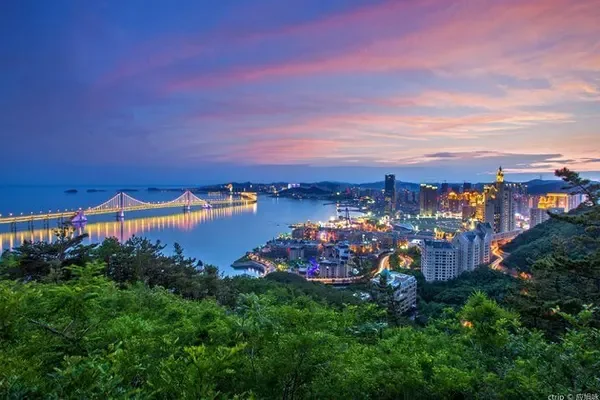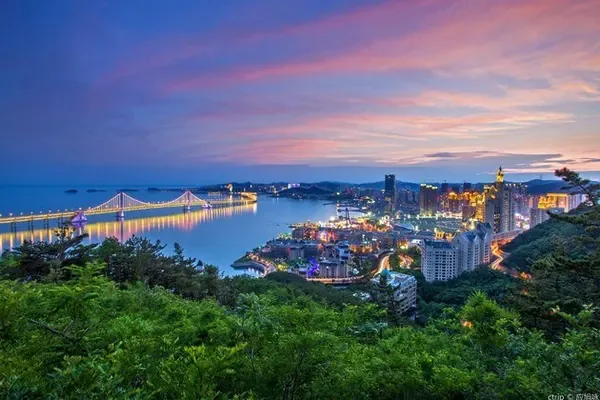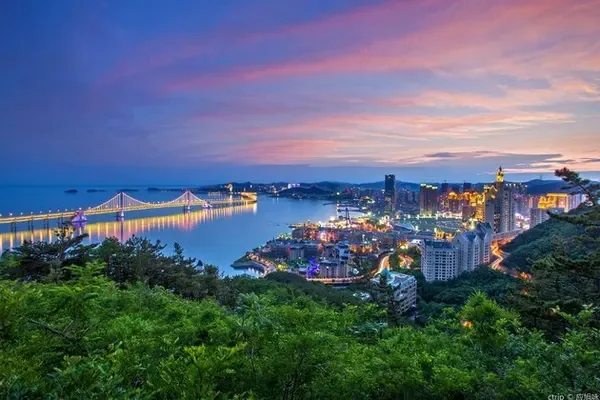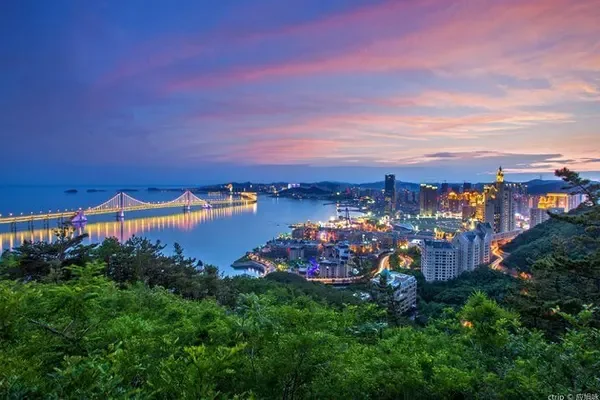Xiangshan is very familiar to Beijingers. Some people go there four or five times a week, and some even go there every day. Most people go to Xiangshan to climb mountains, see red leaves, exercise, and breathe fresh air, but they don't know much about the cultural landscape of Xiangshan. In fact, Xiangshan is very large and rich in content, with many historical sites and cultural landscapes.
Xiangshan refers to Xiangshan Park. It is located at the east foot of the Xiaoxishan Mountains in the northwest suburb of Beijing, 20 kilometers away from the urban area. It is a large-scale mountain forest park with royal garden characteristics. Xiangshan Park was built in the 26th year of Jin Dading and has a history of more than 800 years. The Yuan, Ming, and Qing Dynasties all built a separate palace here, which was a place for royal tourists to stay. In the 10th year of Emperor Qianlong's reign in the Qing Dynasty, pavilions, towers, pavilions, palaces, corridors and pavilions were built here, forming the famous 28 scenic spots in the capital. Later, a wall was built and named "Jingyi Garden", which ranked first among the "Three Mountains and Five Gardens" in the west of Beijing, so Xiangshan Park is very royal.
Because it is close to the urban area, the transportation is convenient, the forest is dense, the environment is quiet, the air is fresh, and you can climb up to see the beautiful scenery of the capital, so it is very popular among citizens. In late autumn, the mountains are full of red leaves and the forests are fully dyed, so it has become a scenic spot for viewing autumn in Beijing.
At the beginning of October, after the National Day holiday, my wife and I spent two days on a rough tour of Xiangshan, mainly the landscape of the shallow mountainous area.

(This picture comes from the Internet)
Day 1: East Gate, Qinzheng Hall, Xiaobailou, Jingcui Lake, Cuiwei Pavilion, Xiangshan Temple, Shuangqing Villa, Laiqingxuan, Xiabiaodeng, Zhishi Pavilion, Laiqiu Pavilion, Zhao Temple, Jianxin Zhai, Liuli Pagoda, Spectacle Lake, Cableway Uphill, Incense Burner Peak, Walking Downhill, Xiangwu Cave, Xiangshan Hotel, East Gate.
Day 2: East Gate, Qinzheng Hall, Zhiyuanzhai, Zhisong Garden, Laiqiu Pavilion, Yuhua Temple, Youqiu Pavilion, Duojing Pavilion, Zhao Temple, Glasses Lake, North Gate, Biyun Temple, North Gate, Qinzheng Hall, East Gate.
(one):

On the first day, enter the east gate.
The parking lot is not small, climb a few steps, and you will reach the east gate in two minutes. The east gate is the main gate of the original Jingyi Garden, facing east from west. There are two bronze lions in front of the gate. The four characters "Xiangshan Park" are inscribed by Guo Moruo.



A pair of bronze lions are mighty, with drooping ears, looking cute and cute.
This pair of bronze lions, cast during the Qianlong period of the Qing Dynasty, has been called "Hanging Palm Lions" for a long time in the past, because each lion has a paw lifted up to hang in the air. In fact, the "hanging palm lion" is the same as most lions, a male and a female. Under the paw of the male lion is a hydrangea, and under the paw of the female lion is a lion cub. Because the hydrangea and the cub were originally bronze, they were stolen. Sold it as scrap copper. After it was repaired and patched, it was stolen again, so for a long time people saw lions with their paws hanging. In 2008, when the Olympic Games were celebrated, professionals restored the "Hanging Palm Lion", and the hydrangea and lion cubs were also restored to their original state, which is what we see today. It is estimated that with the current level of security precautions, no one dares to steal it anymore.



The entrance is a wooden archway, with "Zhong Ling Yuxiu" on the front and "Fragrant and Yiqing" on the back.

The archway Dougong is exquisite and beautiful, the color paintings are exquisite and gorgeous, and the royal atmosphere is strong.

On the screen wall on the north side of the archway, there is a signboard of "Jingyi Garden (Xiangshan)", a cultural relic protection unit in Beijing.


The brick carvings on the screen walls on both sides of the archway are exquisite and vivid.


Behind the archway is the Crescent River and the stone arch bridge, and across the bridge is the Palace of Qinzheng.
Qinzheng Hall is the place where Emperor Qianlong came to the garden to temporarily handle government affairs and meet princes and ministers. It was first built in the tenth year of Qianlong in the Qing Dynasty, and burned down by the British and French allied forces in the tenth year of Xianfeng (1860), and then rebuilt on the original site in 2002. On the front of the hall hangs a gold-lettered plaque "Qinzheng Hall" written by Qianlong's imperial pen. In the hall, there are horizontal plaques of "He He Qi You" written by Qianlong's imperial pen, the emperor's golden throne, carved dragons and gold screens and other furnishings.

Qinzheng Hall has a north and south side hall, which used to be the resting place for princes and ministers. The current South Side Hall is used as the exhibition hall and commodity department, and the North Side Hall is used as the park visitor center.


Both the north and south sides of Qinzheng Hall can go up the mountain. The south side leads to Xiangshan Temple and Laiqingxuan, and the north side leads to the cableway, North Gate, and Biyun Temple. Climb to the top of the incense burner peak.

Xiaobailou was originally one of the 28 scenic spots of Jingyi Garden in the Qing Dynasty - Lvyunfang. It was burned down by the British and French allied forces in 1860. Later, the Xiangshan Kindergarten built a library on the old site, commonly known as "Xiaobailou". After the Central Committee of the Communist Party of China was stationed in Xiangshan, it became the Central Library of the Communist Party of China.



Xiangshan Hotel is located in Xiangshan Park. It was formerly the largest palace in the original Jingyi Garden - Xulangzhai. It was designed by the internationally renowned Chinese-American architect Mr. I.M. Pei, integrating Chinese classical architectural art, garden art, and environmental art. . Relying on the mountain, the hotel is high and low, winding and winding, with alternate courtyards, rocks, lakes, flowers, trees, and the main building with white walls and gray tiles.
If the parking lot outside is full, it is a good choice to park your car in the parking lot of Xiangshan Hotel. You can also have lunch or dinner here after shopping. The first floor is relatively popular, while the second floor Shanhaijing is relatively high-end, with an elegant environment, and the food is very good. Except for the price, there is nothing wrong with it.

Jingcui Lake, formerly known as "Baishuiping Mountain" in Jingyi Garden, was rebuilt and named Jingcui Lake. The lake is clear and green, the trees are tall and straight, and the shape is beautiful.


The winding path leads to a secluded place, and the flowers and trees in the meditation room are deep.


Cuiwei Pavilion, built in the reign of Qianlong, is one of the twenty-eight scenes of Jingyi Garden.

Flowers and plants are all over the mountains.



The trees are lush and soaring to the sky.



Yingluoyan, first built in the Ming Dynasty, is a man-made stone mountain with spring water flowing down, and the sound of gurgling water is pleasant to the ear.

There is a small pavilion next to it, and the plaque reads "Qingyin".

There is an open pavilion above it, and the plaque written by Kangxi is inscribed "Deep in the Green".


In the depths of Luyun, there is a wooden archway facing north and south, with four pillars, three rooms, and seven floors with bucket arches.

After passing the crown archway of the capital, you will arrive at the foot of Xiangshan Temple. There is a pool with white marble railings called Zhilehao. You can feel the traces of time through the gradually blurred carvings on the stone railings. It turns out that this is the temple of Xiangshan Temple. Release the fish pond.
About Xiangshan Temple: According to records, there were two temples in Ji'an and Xiangshan in the Tang Dynasty. In the Southern Song Dynasty, the two temples were combined into one, and Jin Zhangzong named it "Dayong'an Temple". It was rebuilt in the Yuan Dynasty and renamed "Ganlu Temple". It was rebuilt in the Ming Dynasty and called "Yong'an Temple". During the Qianlong period of the Qing Dynasty, it was expanded on the original site and granted the "Dayong'an Temple" by the emperor, which is one of the 28 scenic spots in Jingyi Garden. Xiangshan Temple is built on the mountain, well-proportioned, well-organized and magnificent. It used to be the crown of all the temples in Xishan.
In 1860 and 1900, Xiangshan Temple was burned by the British and French Allied Forces and the Eight-Power Allied Forces respectively, leaving only Chirakuho, Tohomatsu, Sala Tree Imperial Monument, Shiping and other relics. On November 28, 2017, after five years of renovation, Xiangshan Temple reopened with a new look.

Xiangshan Temple sits west and faces east, and rises step by step with the mountain from east to west. The Xiangyun Archway can be regarded as the starting point of the east end of Xiangshan Temple.


On the steps, there are towering ancient trees, leading to the Buddhist hall and sitting in the middle. The Jieyin Buddha Hall is the Shanmen Hall. A plaque of "Xiangshan Great Yong'an Temple" is hung outside the store, and the Jieyin Buddha is enshrined in the hall.

On both sides of the hall, there are horoscope screen walls with delicate brick carvings.



On the Jieyin Buddha Hall, on the north and south sides, there are two ancient pines, towering into the clouds, with luxuriant branches, and a strong tree shape. The big branches growing opposite each other on the crown of the tree extend long, much like two believers listening to a lecture with their hands folded. The tree on the south side leans towards the Buddha Hall, and the big stone next to it is engraved with the words "Tingfa Song".
Above Tingfasong is the Temple of Heavenly Kings, and between Tingfasong and Tianwangs Hall is a climbing ramp. Go down a little along the ramp and there is a famous courtyard - Shuangqing Villa. Let's take a look first, and then continue to visit mountain temple.


Shuangqing Villa is the former site of "Songwu Villa" in Xiangshan Jingyi Garden, one of the twenty-eight scenes of Xiangshan inscribed by Emperor Qianlong. In 1860 and 1900, Songwu Villa was looted and burned by the British, French and Eight-Power Allied Forces.
In 1917, Mr. Xiong Xiling, the fourth prime minister of the Republic of China, founded the famous Xiangshan Salesian Hospital and built a villa here to cultivate talents, which is called "Shuangqing Villa".



On March 25, 1949, after the Central Committee of the Communist Party of China and the Central Military Commission entered Beiping, they lived and worked in Shuangqing Villa. Shuangqing Villa was once the command center of the Central Committee of the Communist Party of China. It witnessed the victory of the Chinese revolution. It has extraordinary historical significance and is now a patriotic education base. Visits need to be booked in advance.
After visiting Shuangqing Villa, continue to Xiangshan Temple.

In the Hall of Heavenly Kings, Maitreya Buddha is enshrined in the center, Wei Tuo is enshrined in the back, and the four heavenly kings are enshrined on both sides.

A stone tablet behind the Tianwang Hall is covered by a glass cover, leaving only the top exposed. This is the "Sala Tree Song" tablet. The stele is in the shape of a regular square, made in the thirty-eighth year of Qianlong. The head of the stele is four dragon ridges. The body of the stele is engraved with "Sala Tree Song" in four languages: Manchu, Han, Mongolian and Tibetan. Monument.
In the southwestern imperial book of the stele is a poem "The Sala Tree": "The year of the Sala tree in the Xiangshan Temple is unknown. It is green and towering, and the leaves come out seven times, just like when the Seven Buddhas are finished."

On the south side, there is a "Monument of Repaying Gratitude to Yong'an Temple in Xiangshan".


Bell and Drum Towers on both sides.

There is a hexagonal mandala on the north and south sides of the middle, and there are original Tibetan statues in the mandala. Thangkas are arranged in the reconstructed mandala, replacing the original statues with Thangkas.


Above the mandala is a wooden archway, with "Yong'an" on the east and "Nanlu" on the west, and the names of the two previous temples are written on it.


The Yuanling Yingxian Hall is the main hall of Xiangshan Temple, which is equivalent to the Daxiong Hall. The entrance is blocked and no entry is allowed.

In front of the Yuanling Yingxian Hall, there is a stone screen built during the Qianlong period, and the whole is made of white marble. On the east side of Shiping, Emperor Qianlong engraved the "Prajna Paramita Heart Sutra", "Vajra Prajna Paramita Sutra" and "Eight Great People's Enlightenment Sutra". Lamp ancient Buddha, Avalokitesvara Bodhisattva statue.


Yuanling Yingxian Hall is beautifully built with high regulations. The roof is made of yellow glazed tiles and green trimmings. The main ridge is big with a big owl kiss, and the glazed dragon decoration on the ridge runs through the whole ridge.

The ridge brake is dazzling. The brake seat is a blue glazed vase with a lotus seat on it. On the lotus seat is a five-layer phase wheel. On the top is a canopy.

There are seven beasts on the vertical ridge, and the fairy rides a chicken, followed by a dragon, a phoenix, a lion, a heavenly horse, a sea horse, a lion and a fish, and the high specifications are evident.

After Yuanling Yingxian Hall, there is the last group of buildings in Xiangshan Temple. Above the steps is a hall hall called "Wide Eyes". According to the usual temple pattern, this should be the location of the Buddhist scripture building and the back garden.

In the middle of the stacked stone rockery, there is a three-story octagonal gray tile pavilion with a single eaves and a pointed roof. It is called Xipu Xianglin Pavilion, which is a bit like the Buddhist Incense Pavilion in the Summer Palace.



There are corridors on each floor and plaques on the front.




The stone ramps on both sides of the Xianglin Pavilion in Fupu can lead to a mountain hall in the middle of the mountain, and the climbing corridors along the walls on both sides can lead to the Qingxia Jiyi Building on the top.

After leaving the Xiangshan Temple, I didn't continue to go up, and came to the gate of Laiqingxuan. In 1949, after the central government stationed in Xiangshan, Zhu De, Liu Shaoqi, Zhou Enlai, Ren Bishi and other leaders of the Communist Party of China once lived and worked here.

To the east of Qingxuan, there is an ancient mountain gate with a plaque saying "Lengjia Miaojue".


Go through the gate of "Lengjia Miaojue" and go down the mountain.


Xiabiaodeng, located under Shibapan, was first built in the Qianlong period of the Qing Dynasty and is one of the 28 scenic spots in Jingyi Garden. It was originally the three open pavilions between the pedals of the "Nine Songs and Eighteen Plates", where you can see the rising clouds. Emperor Qianlong had a poem "Treading to see the rising clouds", so it was named Xia Biaodeng.

Zhishi Pavilion was originally built in the Qing Dynasty. It is a three-story hexagonal pavilion. It was built by Emperor Qianlong to express his filial piety to the Empress Dowager. Its name contains the meaning of "knowing the time when you see it, moving at the right time, following the weather, and cherishing the time". The pavilion originally collected tribute clocks and watches from Western countries. The restored Zhishi Pavilion is set up with clocks and clocks as it is, for people to "know the time" and cherish time.


There is a self-ringing bell on the top floor of the pavilion, and a gilt copper phoenix flag is placed on the top of the treasure. The golden phoenix spreads its wings against the wind and is truly majestic.



Come to Qiuting, wander among the pines and cypresses in the forest, and head towards Zhaomiao.

A piece of emerald green is dotted with red leaves, as if telling people that autumn has come.

In the shade of the green forest on the mountain, a glazed pagoda stands impressively.


Go on and come to Zhaomiao. The full name of Zhao Temple - Zongjing Dazhao Temple is a temple of the Gelug Sect of Tibetan Buddhism.
The Temple of Zongjing Jokhang was built by the Qing court to receive the sixth Panchen Lama in Beijing, including the Rehe Xumi Fushou Temple and Xihuang Temple in Beijing, where the Panchen Lama was stationed in different seasons during the Qianlong period.


The glazed archway in front of Zhao Temple is one of the ten existing glazed archways in Beijing. As the highest grade among the archways, it is exquisite and grand, and it is also a business card of Xiangshan.

The plaques on both sides of the archway are written in Manchu, Han, Mongolian and Tibetan, which is unique among the plaques. The plaque on the east side: Fayuan Yanqing, the plaque on the west side: Huizhao Tenghui.

The heart of the square is decorated with six dragons.


Above the arches on both sides is also the "two dragons playing with pearls" with the most gorgeous glaze decoration.



The stone carvings on the arch gate and the base are all exquisite.






The entire Zhaomiao building, in addition to exquisite workmanship, also shows a full Tibetan style everywhere.

Go north from Zhaomiao, cross the stone bridge, and come to Jianxinzhai. Jianxinzhai is one of the few buildings in Xiangshan that has not been destroyed by the Eight-Power Allied Forces.

Jianxinzhai was built in the Jiajing period of the Ming Dynasty, and was repaired in both Qianlong and Jiaqing. It is said that it was once the place where the emperor admonished his subjects. It does not belong to the twenty-eight scenic spots of Jingyi Garden, but is one of the two scenic spots in Jingyi Garden, which are Jianxinzhai and Zhaomiao.


Jianxinzhai is a garden within a garden with a Jiangnan flavor.


In the garden, there are jagged mountains and rocks, green pines and cypresses, pavilions, terraces and pavilions, and water surrounds the mountains. It is a quiet place.

Go up along the wall of Jianxinzhai, climb over dozens of rock-paved rugged mountain roads, and arrive at the glazed pagoda of Zhaomiao Temple.


The full name of the Liuli Pagoda is the Liuli Wanshou Pagoda. It was built in the 45th year of Qianlong in the Qing Dynasty. It is the last group of buildings in Zhaomiao. The base of the pagoda is an octagonal xumizuo, and there are 80 glazed niches on the surface of the pagoda, with copper bells on the eaves.

The glazed pagoda was once burned by the British and French allied forces, and the wooden buildings and stone Buddha statues were destroyed. Renovated in 1965, it is now a landmark building in Xiangshan Park
. I learned that there are only three glazed pagodas in Beijing, one in the Summer Palace and one in Yuquan Mountain. This glazed Longevity Pagoda in Xiangshan is the largest one.
After watching the glazed pagoda, pass the glasses lake, go to the Xiangshan cableway station, and overlook the beauty of Xiangshan and Beijing city from the air.



Xiangshan has dense forests and a quiet environment, which is not only popular with people, but also a paradise for birds. With the enhancement of people's awareness of animal protection, birds are no longer afraid of people, so various birds can often be seen playing or looking for food, which adds to the fun of playing.



The Xiangshan cableway station is close to the north gate of the park. It has been many years since I took the Xiangshan cableway. Such equipment is rare now, but it looks very friendly, as if I have returned to my childhood. The biggest advantage of this kind of equipment is that there is no obstruction, the field of view is wide, and it is convenient to take pictures.
The first sightseeing cableway in Beijing is the Xiangshan Cableway, which was officially put into operation as early as 1982, and it takes about 18 minutes to run one way. Sitting on the cable car, you can have a panoramic view of Xiangshan Mountain and the capital city.

Zhao Temple.

Glass Pagoda.

Spectacle Lake.

Vajra Throne Pagoda of Biyun Temple.

Xiangshan Hotel.

CCTV Tower.

Guomao, China Zun.

summer palace.

The five-color mountain appeared for the first time.


The end of the cableway is Chongyang Pavilion, which is also the highest point of Xiangshan Mountain - Xianglu Peak.
Xianglu Peak is the best place to overlook the scenery of the capital, the weather is beautiful, the weather is sunny, and the view is the best in the afternoon.






Wangjing City on the Chongyang Pavilion, east, west, north, south, the streets are neat, several landmark buildings have obvious characteristics, not many super high-rise buildings, the overall is stable and majestic, which is very consistent with the style and appearance of the ancient capital.


The Summer Palace and Yuquan twin towers are dotted among the green water and green mountains.

The road twists and turns like a ribbon.



When the sun sets, the afterglow of the setting sun fills the capital city, and the whole city is full of clouds and rosy clouds. It is quiet and warm, old and young, full of vigor and vitality. Standing on the top of Fragrant Hills, I sigh in my heart: I love you - Beijing.



The trees are turning yellow and the leaves are turning red, and the most beautiful autumn in Xiangshan is coming.
With the setting sun, we walked down the mountain, and when we passed the Xiangwu Cave, it was closed.

Xiangwu Grotto was built in the tenth year of Qianlong, and it is the one with the highest geographical location among the twenty-eight scenic spots in Qingjing Yiyuan. Because it is located in the middle of the mountain, shaded by greenery, quiet and elegant, and filled with fragrant vegetation, it is called Xiangwu Cave.



There is a small archway in the east, south and north respectively.


There is a large archway to the west. There is the famous "Xishan Qingxue" monument on the north hillside.

When passing Xiaoyouting, it was completely dark. Although the road down the mountain is not illuminated, it is neither dark nor lonely. There are people going down the mountain in twos and threes. I feel that climbing Xiangshan has become a habit of many Beijingers.

In the evening, I had dinner at Shanhaijing on the second floor of Xiangshan Hotel. The food is exquisite, the environment is elegant, and the taste is good. Apart from being a bit expensive, everything else is impeccable.
(Finish)



